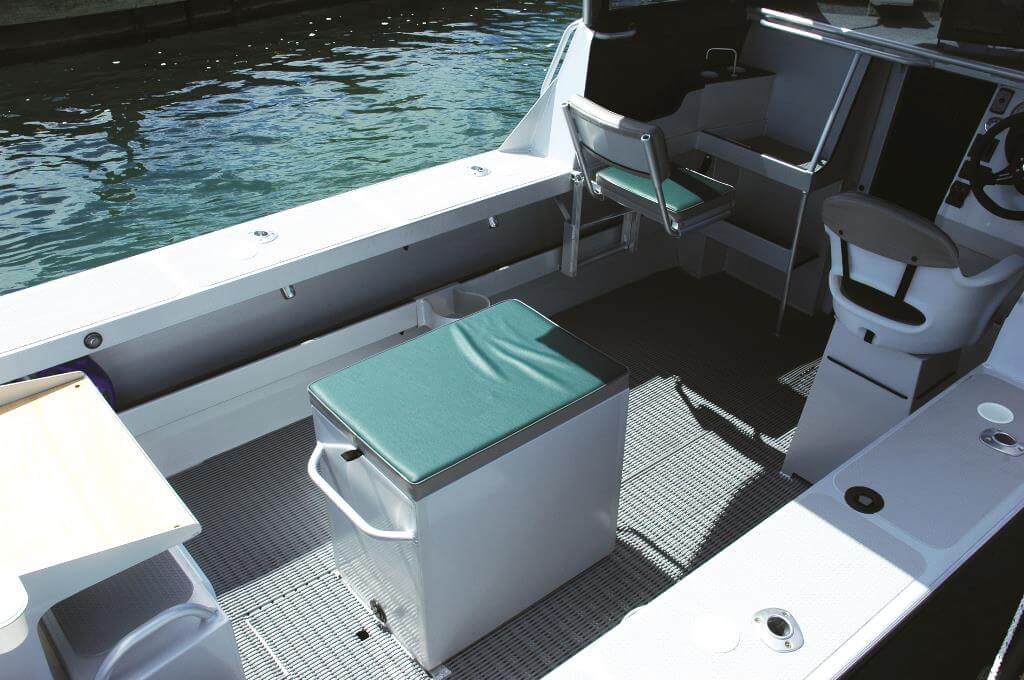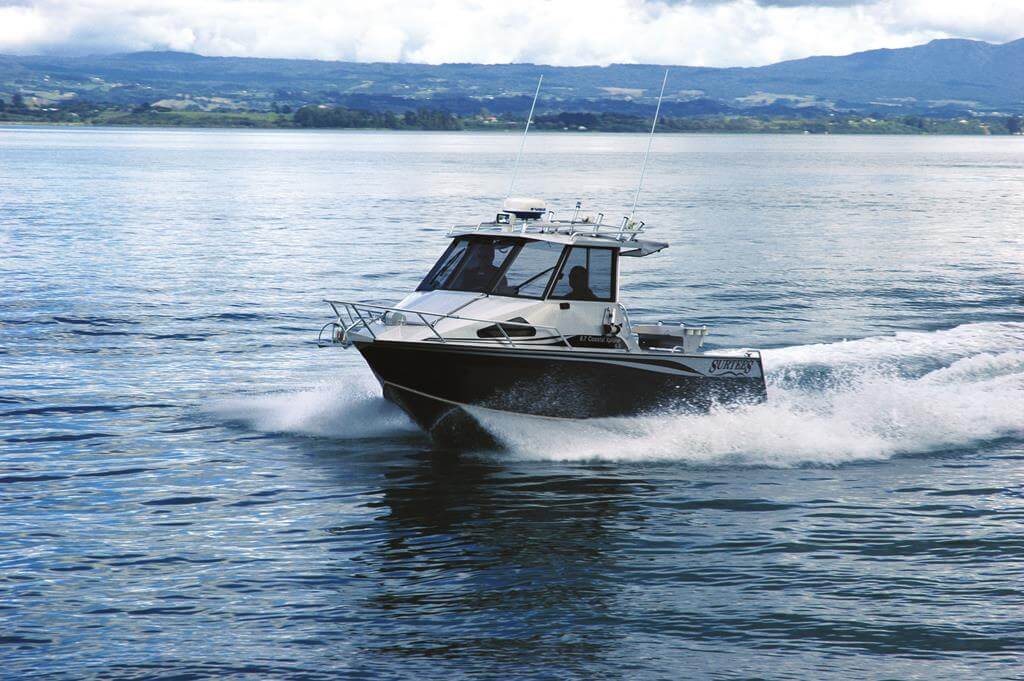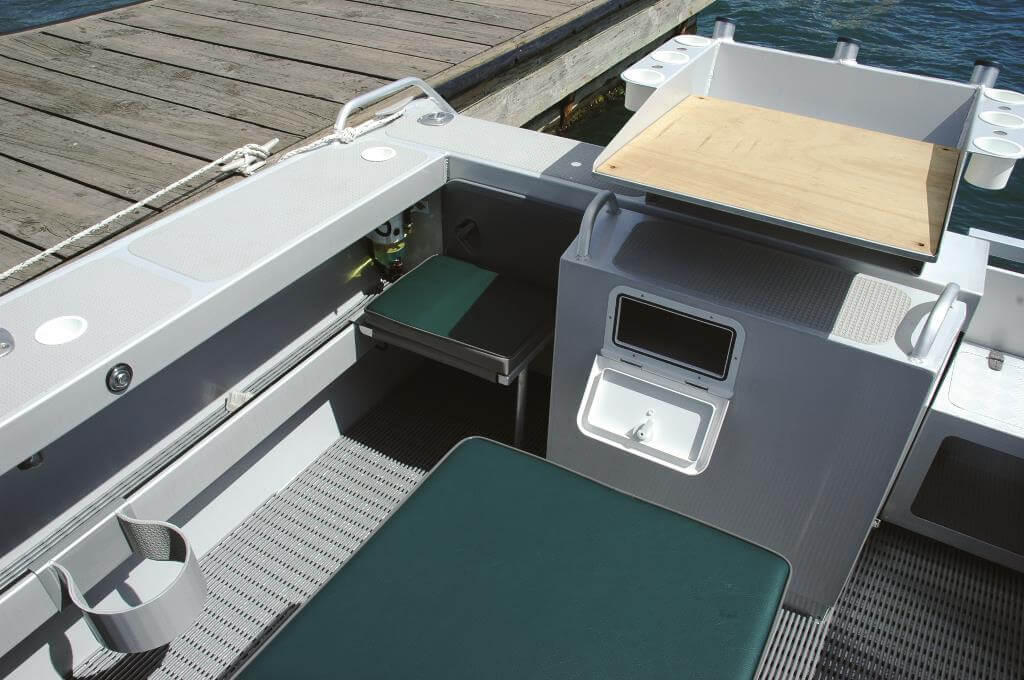Exploring the Boundaries
The 6.7 Coastal Explorer is a new model to the Surtees range. The first boat, built as a charter vessel, was powered with twin outboards. Freddy Foote went to Tauranga and tested out boat number two, powered by a Volvo-Penta D3 diesel sterndrive.
The Surtees range of aluminium trailer boats has always had a strong fishing pedigree. Surtees boats have become well known for their innovative flooding ballast chamber, and their internal innovations.
The test boat was built for an Australian customer, who wants to use the boat for long game fishing trips off the coast of Fremantle.
The design criteria specified that it had to be built for long range cruising around the 22-knot mark, have a large fuel tank to allow the boat to go all weekend on a single tank of fuel and, being a gamefishing boat, it had to be able to accommodate big marlin, game chairs, etc.
“We’ve pushed the cabin forward on this boat. Being a gamefishing boat, overnight capabilities weren’t a big issue, so we’ve shortened the interior berth and the cabin by 400mm,” says Phill Noblett, of Surtees Boats.
“On our standard 6.7 model, there isn’t enough room to accommodate an inboard engine, so by moving the cabin forward, we’ve given ourselves that 400mm aft, allowing us to fit in the diesel.”
Game Fish Deluxe
Forward in the cabin, a large deck hatch allows access to the forward anchor locker. Inside, the cabin is fully lined with carpet and it has a V-berth with an infill, with storage space underneath. Also, the filler cap for the 22-litre fresh water fuel tank is located here under one of the squabs. An electric toilet is also fitted, and privacy can be assured with the sliding, lockable door.
A whole host of seating layouts can be arranged on the Coastal Explorer. On the test boat, he forward passenger seat on the port side sits on a hinge and can be stored down and out of the way, or easily secured in place when wanted for use. A backrest can be fitted quickly by adding two aluminium poles, then sliding the backrest over the top. This seat can either be used facing forward, or facing aft, if you’re wanting to keep an eye on the lures while trolling. Additional passenger seating can be moved around the boat at will, by simply fitting onto the sides of the cockpit shelves, meaning you can have them positioned at any point along the sides of the cockpit.
To the left of the passenger seat, there is a freshwater drinking tap that sources its water from the 22-litre onboard tank. Immediately forward of the seat is a large storage shelf, and a slightly smaller one below, which also doubles as a footrest. A carpeted side pocket is also located here, as on the starboard side.

Storage on the starboard side for the helmsman comes in the form of a slightly smaller shelf/footrest lower down.
Removable dive bottle holders work the same way, and there is enough room to have 10 dive bottles positioned along the side of the boat.
A cray pot lifting arm aided by a capstan which is fixed into the cockpit side, is also another feature built into this boat. The arm itself can be positioned along the starboard side.
Grab rails are plentiful around the boat, with a large rail situated for passengers to hold onto as well as rails along the sides of the helm area, and above along the edge of the cockpit roof.

One of the most prominent features of the Coastal Explorer is the fish bin seat in the middle of the cockpit, which on first glance gives the boat a real game fishing feel.
This large bin is removable, and is fixed in position via a couple of hinges. When removed, a game chair can be fitted using the same hinges. This easy transformation allows you to turn the boat from a bottom fishing boat into a game boat quite quickly.
Aft, the extra large bait board is a prominent feature and provides plenty of working space for the rigging of baits etc. A tuna tube is built into each corner of the boat itself, and is fully plumbed, feeding off the 2000 gallon per hour pumps on each trim tab. A berley bucket is built into the boarding platform, and in the port corner a T-bar dive ladder is a great feature. A fully plumbed live bait tank is located in the port corner, with a see-through window an added feature.
Aluminium telescopic game poles are easily fitted onto the side of the cabin, with mounting plates permanently fixed there.
The helm area was tidy and was absolutely full of accessories. As well as the engine instruments, there were controls for the trim tabs, the spotlight on the roof, Quick windlass, wipers, and all the usual onboard systems controls. Both a VHF and a CB radio are fitted. Prominent features are the huge Furuno Navnet VX2 display, the perfect bit of kit for gamefishing offshore, and a Furuno radar.
Every bit of space is utilised to the utmost. In fact, I think I saw one of the greatest innovations I’ve ever seen on a trailerboat – it had a pie warmer! When Phill was showing me through the boat, I pointed at a small hatch on the engine cover, and asked what it was. “Oh, that’s the pie warmer” he replied. After checking it out, I learnt he wasn’t having me on. A small cubby hole has been built into the upper reaches of the engine cover. When the engine is running, this cubby hole or ‘warmer’ will stay at around 80-90 degrees C.

Offshore Performer
As the photos show, the Coastal Explorer looks to be running quite flat, with the water peeling off the bow section quite far forward.
The front of the boat is quite deep, which aids in the boat’s handling in rougher water conditions. Spray rails run down both sides, deflecting water downwards, the end result being a very dry riding boat.
Moving the cabin of the boat forward causes a forward shift of the centre of mass, making the boat run flatter. However, it is quite trim responsive and has been intentionally designed to handle the rough water conditions off Western Australia.
I tested the Coast Explorer a couple of miles off the coast of Tauranga, in a gentle rolling swell, so I didn’t really get to test the boat in any gnarly conditions. However, getting a bit of air under the boat off a couple of the bigger swells delivered a nice soft landing.
The Coastal Explorer has a comfortable cruise speed of 22 knots @ 3100rpm using around 18 litres per hour. The maximum speed we managed to achieve was 29 knots at 3950rpm, just 50rpm short of the maximum recommended rpm of 4000, and using 33.7 litres per hour. We also looked at the trolling speed of the boat, obviously the type of boating where the boat will spend a large part of its time. At 7.0 knots at 1800rpm, the 160hp D3 Volvo Penta was using just 4.6 litres per hour, and given the 300-litre fuel tank, you can see that the range is pretty good, to say the least. The flat running attitude of this boat is helped by the fact that the all-aluminium Volvo-Penta D3 Duoprop is extraordinarily light, at just 330kg dry weight excluding propellers.
Safety is a key point in the Coastal Explorer, with every possible eventuality covered for boating offshore. The boat runs twin water separating fuel filters with warning lights on the dashboard; meaning you will be aware of the problem before the water gets into the engine. Twin 900-Ah batteries are also installed, with twin charging circuits and voltage sensitive relays. Two 2000 gallon per hour bilge pumps are also installed, so when offshore, if a wave were to come over the back while you’re backing up on a fish, the water is going to be evacuated quickly.

The engine bay is air and water tight apart from the breather which is at the top of the gunnels, so any water that enters the boat will not get into the engine bay. If for some reason, water does get in there, for example if a hose comes off, a 1500 gallon per hour bilge pump will take care of it. These pumps are automatic, and operate 24 hours a day, a handy feature if the boat is moored for long periods of time.
Again, Surtees has come away with what seems to be a boat that will do its job exactly the way the owner has specified. Look to see a twin outboard powered model at the upcoming New Zealand Boat Show, and also look to see if Surtees has come away with another prize winner.
Specifications
- Model: Surtees 6.7 Coastal Explorer SD
- Price as Tested: $108,000 +GST
- Designer: Neil Surtees
- Material: Alloy
- Type: hardtop
- LOA: 7.0m
- Beam: 2.35m
- Deadrise: 19 degrees
- Hull Configuration: monohull
- Trailerable Weight: 2400kg
- Height on Trailer: 3.0m
- Engine Capacity: 130-190hp (diesel) 140-250hp (outboard)
- Power Options: Sterndrive, single/twin outboard
- Fuel Capacity: 200-300L
- Water Capacity: 22L




